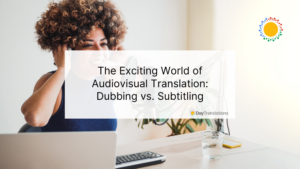We can safely say that in today’s world, both on and offline, video is the king of content. Taking this into account, you might wonder what that has to do with voice-overs. Let’s just say it has everything to do with it. Keep reading today’s blog to find out more about the benefits of voice-overs and how they can add significant value to the content you produce.
What is it and What are the Benefits of Voice-Overs?
Let’s start with the basics and work our way up. What is a voice-over? Well, to put it very simply, a voice-over is a recording mode where the voice or narrative is unseen, only heard. The purpose of this sort of technique can be for quite a few reasons, including telling a story, giving information, translation, and even localization purposes.
One of the main reasons why voice-overs exist is to provide accessibility. More than half the world’s population are not native English speakers. This is important to note because, in the United States alone, approximately 67 million people do not speak English as their first language.
The irony is that English is considered a universal language from a global perspective. As such, many learn it as a second language for businesses and other processes to run as smoothly as possible.
The Different Styles of Voice-Overs
Of course, there are different ways in which a voice-over can be done. They include the following:
UN-style Voice-overs
This voice-over style is often used for publications featuring people of ‘noteworthy-ness’ who may not speak your language. The technique involves the audience still hearing the original speaker’s voice at a low tone while the voice actor takes over, usually speaking in a different language.
Dubbing
Dubbing in the voice-over world is really lip-syncing loudly. In this style of voice-overs, the original audio from the video footage is wholly replaced, and in this case, voice actors translate and narrate in sync with the actors on the screen.
Narration
Narration can incorporate UN-style or dubbing-style voice-overs; it all depends on whether or not the talent is on-screen or off-screen. If the talent/actors are on-screen, then dub or Un-Style can be used. If they’re off-screen, then there can be a narration.
The Benefits of Voice-Overs for Your Audiovisual Content
It Breaks Language and Cultural Barriers
Language barriers hinder smooth and effective communication. That said, including voice-overs in your audiovisual content provides greater accessibility for those who are not fluent in the source language of your video.
Additionally, your content is more than likely going to be skewed to your culture through the use of specific slang and phrases. Through the use of voice-over, along with the localization process, it helps to break down these cultural barriers, allowing those who would not have been exposed to your culture in that way much more leverage in understanding what is taking place.
Increases Conversions to Your Content
You can use audiovisual content for multiple purposes. That said, depending on what it is used for, when you add language support to it as a voice-over, it helps to drive conversions and increase sales.
When your audience can receive the information you provide in a language that they speak, it becomes just as important to them as the product they’re trying to find out more about. The voice-overs also create greater accessibility to your videos overall.
It improves the customer experience. Whether in-person or online, the customer experience matters all the time. With this in mind, video content makes up more than 80% of the content found on the internet today.
There are many types of video content, including tutorials, testimonials, reviews, product/service features, how-to’s, and so much more. By itself, video content sells and does well. What enhances the experience it brings for both the consumer and the supplier is adding voice-over.
Why? Well, let’s say, for instance, your video is recorded in English, but you serve a global audience that has an extensive range of non-English speakers. Your content becomes just as valuable to non-English speakers thanks to the power of adding voice-overs to your video. This way, no one is missing out.
It Improves the E-Learning Experience
Online learning is now the norm for so many subject areas. We could safely say that videos offering voice-over options significantly improve learning quality, especially for non-native learners.
While subtitles and transcripts help greatly, they can cause information overload for the student because they have to pay attention to the video and reading to understand what is happening.
Implementing voice-overs in the learning experience makes the learning tools much more user-friendly, and it improves overall comprehension, especially for those who do not speak the source language of the video.
Some Prefer Voice-Overs Over Subtitles
While subtitles and voice-overs have the main aim of providing accessibility, there are just some audiences who prefer voice-overs to subtitling. For one, voice-overs eliminate the need for reading along to follow what’s going on, and voice-overs also allow for a less intense viewing experience because the potential of missing any information is significantly lowered.
Voice-overs also facilitate the comprehension of those who do not read very well.
Final Notes on the Benefits of Voice-Overs
We cannot begin to stress how important it is to make your content accessible. Voice-overs help to make this possible for your audiovisual content.
At Day Translations, providing professional voice-overs for you is our priority. We provide voice-over services in every language. Our professional mother-tongue voice actors do their job with you in mind. We want your content to be enjoyed by your audiences in the most stress-free way possible.
Request a quote today to get started.














Sorry, the comment form is closed at this time.